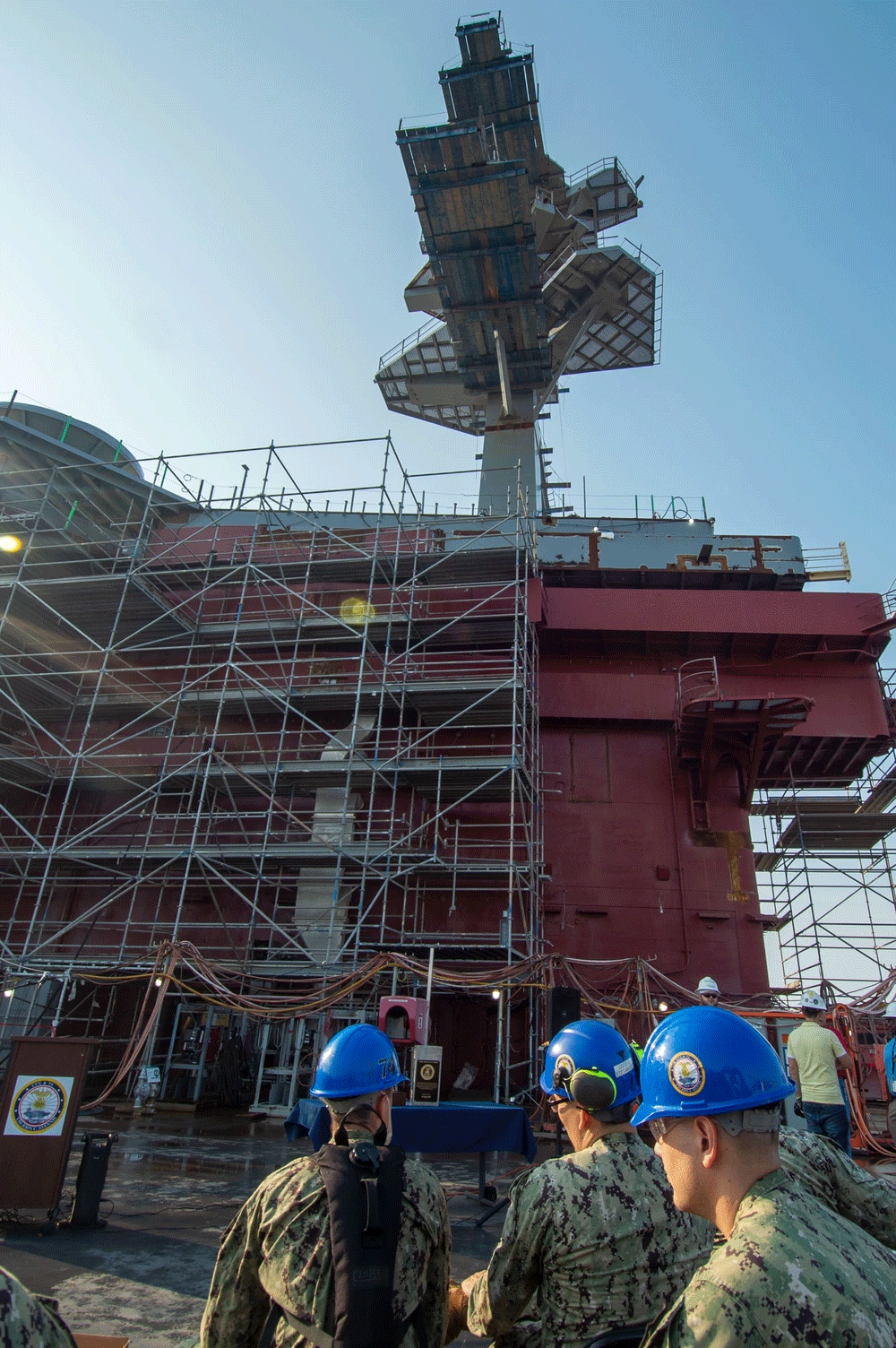The crew of the Nimitz-class aircraft carrier USS John C. Stennis (CVN 74) and members of Newport News Shipbuilding marked a major milestone in the ship’s refueling, complex and overhaul (RCOH) maintenance period with a mast stepping ceremony, July 26.
The event, held in accordance with almost a millennium of naval tradition, marked the placement of Stennis’ new main mast, not only giving the ship a part of its identity back, but also providing a platform for new combat system capabilities and a safer way for Sailors to climb the mast.
Speakers at the event included Capt. J Patrick Thompson, Commanding Officer of John
C. Stennis, Lt. Cmdr. Marco Guidi, Combat Systems Officer, and guest speaker Ms. Jessica Gomez, Program Director for In-service Carrier Programs at Newport News Shipbuilding.
“This mast stepping allows us to acknowledge our past as we move into the future,” Said Thompson. “While the mast of the days of sail represented propulsion, the new mast you see here represents pure combat capability –the ability to guide an aircraft home on the darkest of stormy nights; the ability to communicate and share targeting data with other ships and aircraft via encrypted, jam resistant networks; or the ability to coordinate offensive action with our Navy and Joint partners via low probability of intercept communications.
The new square and tapered mast, which replaced the smaller, round-shaped pole,
provides a larger area to host state-of-the-art defense and communications systems that will help carry the ship into the future.
“This team has put its heart and soul into USS John C. Stennis, and we’ll continue
to give our all to prepare her for the second half of her life,” said Gomez. “When she leaves our shipyard to return to the call of duty, Stennis will be equipped with updated aircraft launch and recovery equipment to support the latest aircraft, cutting edge combat systems to protect the ship and the most advanced carrier IT network.”
The practice of mast stepping is not a new. In fact, according to The Society for Nautical Research, the tradition is likely to be as old as shipbuilding itself. Dating back more that 2000 years ago, the ritual has evolved over time and led to Vikings and seafarers of the north who would place coins, amulets and other offerings beneath the masts of their ship for good luck.
Even the USS Constitution, one of the U.S. Navy’s six original frigates authorized for
construction by the Naval Act of 1794, had coins placed beneath her mast in conformity with this time-honored naval tradition.
The practice continued even after the advent of steel-hulled ships, commemorative time
capsules containing coins and other remembrances of the current era welded to the mast “step” in lieu of coins being placed beneath a wooden main mast.
“Even a short ceremony like this means a lot to our Sailors and myself,” said Guidi. “So many aspects of our job go back thousands of years, and maintaining these maritime traditions and ceremonies remind us where we came from. Although I work with some of the most advanced systems on the ship, I still enjoy the historic traditions.”
Items placed in the capsule, which was welded to the Stennis’s mast step after the
ceremony, included a full roster of the ship’s crew, a commanding officer’s coin and the ship’s mid-life coin.
Unlike other types of ships, modern carriers typically undergo mast stepping twice; once during initial construction, and then again when the ship goes through the RCOH process.
The Stennis, however, is unique that this will be the ship’s third mast stepping, the
second installment taking place in 2005 during a planned maintenance availability. Items retrieved from the last time capsule, placed nearly two decades ago, will be placed in the Stennis Room aboard the ship for Sailors to come observe and reflect upon a different time in the carrier’s history.
“I had the pleasure of serving as this ship’s executive officer during its most recent
deployment and saw the capabilities of this warship,” reflected Thompson. “Today, we see the next step in its transformation into the most technologically advanced Nimitz-class carrier in the fleet. The amount of hours and dedication put into not only the mast, but revitalizing this ship as a whole is truly remarkable- the strength of our U.S. carrier force is a testament to each individual who has played a part in getting this ship back in the fight.”
The John C. Stennis entered RCOH at the Newport News Shipbuilding, May 2021, for her
mid-life refurbishment, preparing the aircraft carrier for an additional 25 years of service.

